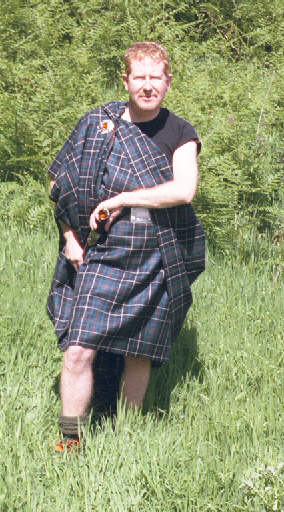In 1618, a poet from London, John Taylor described the costume of Scottish aristocrats, lairds, and their followers and servants, dressed for hunting at Braemar. In August and September, all classes dressed in the same fashion by custom, as if equals. This included tartan stockings and jerkins, with garters of twisted straw, and a finer plaid mantle round their shoulders. They had knotted handkerchiefs at their necks and wore blue caps. Taylor said the tartan was "warm stuff of diverse colours."
Ja, originalkliten är mer en toga än dagens kiltar.
The kilt itself in its original form was a very basic garment which required neither the trouble of tailoring nor the frequent replacement which a pair of breeches needed. The tartan cloth forming a piece of material some 2 yards in width by 4 or 6 yards in length. This was known variously as the Breacan, the Feileadh Bhreacain and the Feileadh Mor - the big kilt, usually referrred to in English as the belted plaid.
To put it on, its owner "put his leather belt on the ground and then placed the material lengthways over it. This he then methodically plaited it in the middle, (suitable to the size of the wearer) over the belt until he had gathered along its length leaving as much at each end as would cover the front of the body, overlapping each other. Lying down on the belt, he would then fold these ends - overlapping each other. The plaid being thus prepared, was firmly bound round the loins with a leathern belt, in such a manner that the lower side fell down to the middle of the knee joint, and then while there were the foldings behind, the cloth was double before. The upper part was then fastened on the left shoulder with a large brooch, or pin, so as to display to the most advantage the tastefulness of the arrangement, the two ends being sometimes suffered to hang down, but that on the right side, which was of necessity the longest, was more usually tucked under the belt."
The belted plaid had many advantages in the Highland climate and terrain. It allowed freedom of movement, it was warm, the upper half could provide a voluminous cloak against the weather, it dried out quickly and with much less discomfort than trousers and if required it could, by the mere undoing of the belt, provide a very adequate overnight blanketing. The tightly woven wool proved almost completely waterproof, something the lose woven wool of today -- is not. When complete freedom of action was required in battle it was easily discarded, and one famous Highland clan battle, that between the Frasers the MacDonalds and Camerons in 1544, is known as Blar-na-Leine, which can be translated as 'Field of the Shirts'.
The garment that was (originally) largely, -- that of the people; and lesser leaders) worn a Leine Croich or saffron shirt, in fact a knee-length garmet of leather, linen or canvas, heavily pleated and quilted, which provided a surprisingly good defense and which was much more mobile (and less expensive) than contemporary plate armour. This form of dress in to be seen on West Highland tombstones right up to the early seventeenth century, worn with a high conical helmet and the great two-handed claymore. For ordinary wear the kilt may be made of tartan or tweed and may be box-pleated or knife-pleated (as are most); for dress wear it should be of the dress tartan of the Clan. If the Clan posses one. The kilt should be worn with the lower edges reaching not lower than the centre of the knee-cap.
Den mer moderna kilten;
The Feileadh Beg, or little kilt, is what is worn today. In essence it consists of the lower part of the old belted palid with the pleats sewn in at the back and neatly tailored (knife pleated), the ends of the kilt's two aprons being drawn across the front of the body and secured usually by buckle and strap. This form of dress may have existed earlier, but there is no sign of it before 1725. It is a severe shock to many people to find that the "little kilt's originator may well have been an Englishman, one Rawlinson, who was employed as the manager of an iron smelting works in Lochaber who adapted it, to allow more freedom of movement for his workers. (Probably so they could work faster being the concerned English they were). Be that as it may, it is this form of garment which is now firmly taken as being the kilt.
Man ska notera att kilten på den tiden bara bars i högländerna, och inte ens av alla där. Låglandsskottarna, som alltid varit i majoritet, ansåg den vara en barbarisk och omodern företeelse och klädde sig hellre efter europeiskt mode.
